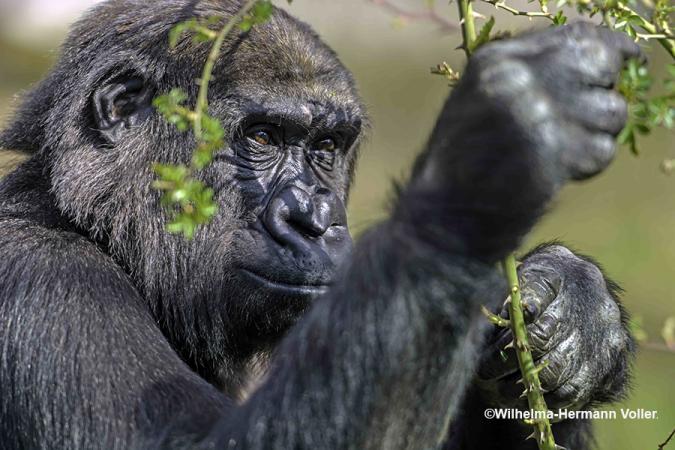
The Stuttgart zoo is one of the largest and well-known zoos within Germany, it draws in over 2.1 million visitors every year. The park covers an area of almost 70 acres, about the size of 40 football fields and is bordered by the Neckar river and the suburb of Bad Cannstatt.
Founded in the 19th century by King Wilhelm the first, the kings vision was truly one of a kind. A private botanical garden, all with a stunning oriental flair, that was in style at the time. And an orange garden; that was a must have for every fashionable ruler back then. The architect tasked with the job, Karl Ludwig Zanth, oriented himself on the Moorish architecture in Spain. Since Alhambra in Grenada Spain had spectacular buildings, the architect decided to copy those and designed a stunning recreation of Alhambra, at the Neckar river. The park next to the castle, with its mineral rich springs, was turning more and more into a vision of Arabian nights, and was named after its creator, Wilhelm.
It is really worth mentioning that the park is much larger then it seems. The Wilhelma garden borders the Stuttgart palace garden, that begins at the palace square, and runs along the Rosensteinpark and the Wilhelma zoo, all accessible though a wide network of walkways and gardening layouts.
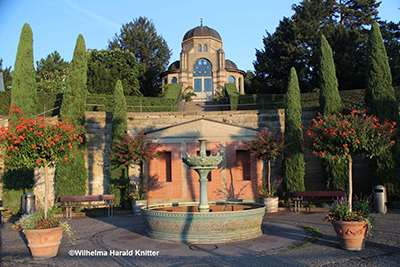 The gardens were only open to royalty and used as living quarters for the king until after the passing of the ruler in 1864, the park was finally opened to the public in 1880 and tickets were sold to eager visitors. People awed over exotic orchids, luxurious roses and enjoyed strolls through the beautiful gardens. During WWII the Stuttgart region with its Wilhelma gardens had to suffer through some horrible bombings and many of the buildings were badly damaged. The Moorish banquet hall was sadly destroyed during the war and demolished soon after the war. The buildings that are still there to this day, have been protected under the German heritage laws. In the years right after the war, the gardens were used to grow food for the city and a few years after the park reopened its gates to the public. The director decided to expand the botanical gardens to bring new masses to the park. He started by constructing animal enclosures. One by one, the park added the aquariums and African plains animals and by 1951 Giraffes and Zebras first moved into the Wilhelma zoo.
The gardens were only open to royalty and used as living quarters for the king until after the passing of the ruler in 1864, the park was finally opened to the public in 1880 and tickets were sold to eager visitors. People awed over exotic orchids, luxurious roses and enjoyed strolls through the beautiful gardens. During WWII the Stuttgart region with its Wilhelma gardens had to suffer through some horrible bombings and many of the buildings were badly damaged. The Moorish banquet hall was sadly destroyed during the war and demolished soon after the war. The buildings that are still there to this day, have been protected under the German heritage laws. In the years right after the war, the gardens were used to grow food for the city and a few years after the park reopened its gates to the public. The director decided to expand the botanical gardens to bring new masses to the park. He started by constructing animal enclosures. One by one, the park added the aquariums and African plains animals and by 1951 Giraffes and Zebras first moved into the Wilhelma zoo.
The historic and Moorish Gardens are set up to compliment the beautiful Moorish buildings within the park. Most of the buildings have been transformed into green houses, the aquarium, animal- and plant houses. The Moorish villa for example was originally planned to be a bathhouse, but after the building was badly damaged during the second world war, it was rebuilt in 1971 and turned into a greenhouse with 5 different rooms and an area that now houses nocturnal animals. The banquet hall was one of the most lavish buildings in the park, sadly after heavy bombing during WW2 the decision was made to demolish the rest of the building and use the area to build the aquarium and crocodile house, remnants of the original building can still be seen on the outer wall that faces the lily pond. The water Lily pond and the many fountains, sculptures and stone vases throughout the park give it a magical flair. In the spring, usually around the beginning of April, the Magnolia Grove with its 70 some trees, is quite a spectacular sight to see. It is the largest Magnolia tree grove north of the Alps. A few of the trees are still some of the original trees planted by king Wilhelm. The Lily pond is another must see sight. During the summer month the water is adorned by over 35 species of different water lilies that change colors all through the summer all the way into October. The giant leaves of the water Lily Victoria Amazonica are big enough to hold children!
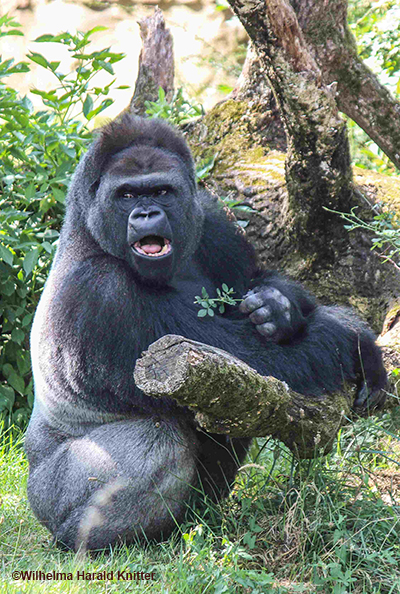 Today the botanical garden and zoo offers an array of 1200 species of animals, 11000 animals all together and over 7000 different plant species and varieties. Gorgeous historic green houses are set throughout the park filled with many exotic plants and sceneries. The park even features 70 giant Sequoia trees. With this magical combination the Stuttgart Wilhema is the most diverse park in the world.
Today the botanical garden and zoo offers an array of 1200 species of animals, 11000 animals all together and over 7000 different plant species and varieties. Gorgeous historic green houses are set throughout the park filled with many exotic plants and sceneries. The park even features 70 giant Sequoia trees. With this magical combination the Stuttgart Wilhema is the most diverse park in the world.
One of the main attractions has to be the newly opened Great Ape House with its gorillas, bonobos and oranng-utan, or maybe you prefer the Insectarium … if you are into bugs. Wilhelma zoo is not only Europewide, one of the zoos with the largest array of animals, but also worldwide. With buildings like the Amazon house, whole eco systems are recreated and animals and plants live in perfect harmony, just like they would in the wild. With its streams and rain forest flair the house provides the perfect home to a diversity of mammals like monkeys, reptiles and fish. Personally, my favorite house is the house of the large cats, where you can find the large felines. Attached to the house are enclosures that give the animals room to roam outside where you can watch tigers, leopards, lions and many more. There are several other houses for animals, like the giraffe house, the elephant house and the sea lion building. The outside enclosures for the zebras, gazelles and antelopes are set up so that species that are normally together in the wild can hang out together in the enclosure. The zoo also takes part in the international breeding programs that are working towards preserving the many endangered species and at the moment has 51 species that fall under the European endangered animal act.
The park is a great place to relax, spend a day with the family or just check out the many animals. The park is set up with several round walks through the garden and zoo, 5 of them to be specific. Depending if you favor plants or animals, the green houses or just want to do a small tour, you will be sure to find something to match your wants.
The biggest reason to visit Wilhelma has to be the many exotic animals that are shown here. While the park is also working on some major remodeling and renovations like a new Elephant area, the new Primate house is a really cool place to spend time. Watching the great apes and the little cousin of the Chimp, the Bonobo, is quite fun. The Aquariums are set up nicely and there are many Terrariums with reptiles and Amphibians. Not to forget is the exhibition farm. Set up with a nice petting zoo, this area is a favorite for kids to meet today’s farm animals and their ancestors. Some of these are considered “less efficient” farm animals and are rarely seen in today’s farming. This is the only place in the zoo where you can actually feed the animals, but only with food you can purchase in the farm area. Other then that the zoo animals can’t be fed or touched.
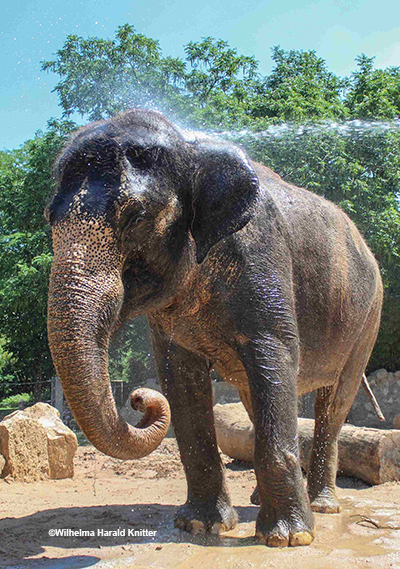 Dogs and other animals are also not allowed in the zoo (service dogs with proper documentation are exempt of course). The park is outfitted with about 800 parking spots that range from 1 to 5 euro depending on the duration of your stay. There are several playgrounds for kids, public toilets and changing rooms are also available. Gift shop and restaurant are also available at the park.
Dogs and other animals are also not allowed in the zoo (service dogs with proper documentation are exempt of course). The park is outfitted with about 800 parking spots that range from 1 to 5 euro depending on the duration of your stay. There are several playgrounds for kids, public toilets and changing rooms are also available. Gift shop and restaurant are also available at the park.
Discounts are given to kids, students, large groups and there are family tickets available. They also offer annual tickets and, this is the best part, “visit with our zoo animals” tickets. Yes, you heard right, you can meet selected animals within the zoo one on one. If you are interested in that contact the administration office directly, since these tickets have to be booked in advance. The zoo also offers guided tours, in front and behind the scenes, contact the zoo for more information and for booking guided tours. There is also the animal adoption program which can make for a very special birthday or anniversary gift, starting at 50 euro up to 5000 euro, depending on the animal and its care costs, you can get everything from a plaque installed at the enclosure to annual entrance passes with your animal sponsoring certificate.
If you are in the market for getting married, but are not into dusty courthouses or old churches, the Wilhelma park may be the place to be for you. They offer a beautiful wedding venue at the Damascene Hall with room for about 50 people.
For more information check the following link:
http://www.wilhelma.de/en/offers-available/weddings.html
You really should set a whole day aside to check out the entire zoo, maybe pack a little lunch and just chill at one of the many playgrounds with the kids. Spring is right around the corner and its time to head outside again.
Interview with Dr. Harald Knitter, the Marketing Manager of the Wilhelma
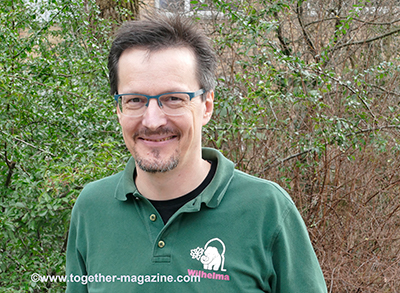 Together-Magazine (TM): Thank you, Herr Dr. Knitter for taking the time for us and inviting us to the Wilhema today. What would you suggest are the attractions of the Wilhema – the “have to see’s” of the park?
Together-Magazine (TM): Thank you, Herr Dr. Knitter for taking the time for us and inviting us to the Wilhema today. What would you suggest are the attractions of the Wilhema – the “have to see’s” of the park?
Dr. Harald Knitter: What makes the Wilhelma truly special is the threefold of the royal residence, the beginning of the Wilhelma, the botanical garden and of course the zoo, that was added after the second World War. If you consider the over 1200 animal species, over 7000 plant species and the 140 different trees, the Wilhelma really is one of the most diverse places in the world. You can’t find another place like this anywhere.
TM: This should be something special for our American readers, after all they know great zoos from back home too.
Dr. Harald Knitter: There actually is in the buildings, that King Wilhelm of Wuerttemberg had constructed in the 19th century, that Moorish style, an oriental architectural style right out of Arabian nights; those buildings are still in use today, as greenhouses or housing animals. Modern buildings like the Amazonas-house round the whole thing up. This is a great example of the combination of zoo and botanical garden. Our zoologists and botanists were able to work together here and recreate a little biosphere just like in the Amazonas region. We have a jungle path that is outfitted with the actual plants from the Amazonas region and the animals, as its possible, live there freely. There are birds, reptiles and amphibians that roam and live there freely. There are a few other animals that we decided not to let roam freely like the Anaconda *chuckles*, you can check it out in a terrarium. We do have a few south American monkeys and sloths, but we did restrict their habitat a bit or they would defoliate our trees too quickly. Other than that, its own unique world, with a constant humidity of 80% and temperatures between 79°F and 81°F. that of course makes it one of the more comfortable areas to visit during the cold winter months, and during the hot days, that get over 86°F in the summer, it turns it into a surprisingly cool place within the Wilhelma.
TM: That does sound interesting, speaking about temperatures, what would be the ideal weather for a visit to the Wilhelma?
Dr. Harald Knitter: Usually our visitors plan their trip here to the Wilhelma a couple days in advance. By the middle of the week they will start planning about excursions on the weekend. And then many start looking at the proposed weather for the weekend. What we have noticed is, that the main thing is: no rain. As long as it is dry outside you can have a wonderful stay here with us. You don’t even really need the sun for that. Of course, there is plenty to see outside, but you can always venture inside also, for example to visit the aquarium, terrarium or the one of the many climate controlled warm houses for the animals that like it warm, rather then the chilly air outside. Many of the animals can decide on their own just like you. There are the beautiful parks and the buildings and as long as it’s dry, you are good to go.
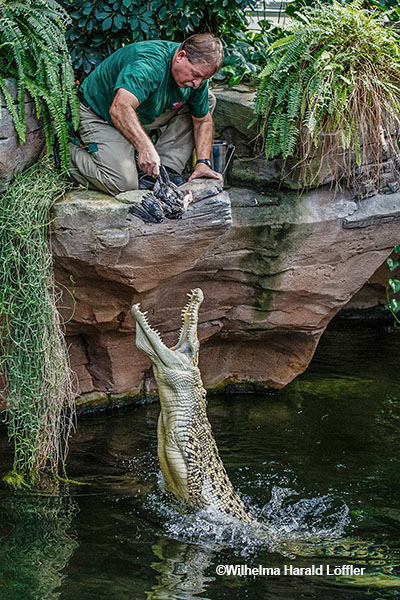 TM: We have many American families that live here in the greater Stuttgart region, so my question is, what is the best way to get to the Wilhelma? Car of public transport?
TM: We have many American families that live here in the greater Stuttgart region, so my question is, what is the best way to get to the Wilhelma? Car of public transport?
Dr. Harald Knitter: The Wilhelma has its own parking garage and on the weekends, there are additional parking garages available in the area for visitors. About 60% of our visitors arrive by car and usually it works well.
TM: On nice days, school holidays and the weekend the radio does run announcements that parking at the Wilhelma is full and to please take public transport.
Dr. Harald Knitter: We would be delighted if more visitors would arrive via public transport, since we are well connected. There is a city tram stop directly at out main entrance, you would not even have to cross a road, there are 3 separate bus lines that stop here and the S -Bahn is only about a 15-minute walk, so you can skip the parking issue.
TM: Are there annual tickets for the family, if you would like to visit often?
Dr. Harald Knitter: Yes, we do offer annual tickets, but they are issued per person, not families. There is no actual family ticket, but a master ticket, that costs 55 € at the moment, an additional annual ticket for your partner is 40 € and a children’s ticket is 15 € annually. So, every member of the family has their very own ticket and everyone by itself can visit the Wilhelma as often as they wish. If you compare that to the normal entry fee it pays itself off within 3 to 4 visits a year at the most.
TM: That means you can actually just stop by and visit the Wilhelma for a couple hours.
Dr. Harald Knitter: Absolutely! Our statistics show that the average visitor spends about 4 to about 4,5 hours here. That’s very well doable, but you haven’t seen it all by far then. That areal here is 75 acre big and visitors try to see as much as possible during their visit. If you are from the area and have more time available it can be quite exciting to stop by for just an hour or two. When there are new born animals, for example a baby antelope or gorilla, it is very doable to stop in for an hour and just visit that new addition. There is no rush to keep going and see it all. Of course, our botanical garden has different times to see the plants in bloom – times that are very worth visiting. This starts fairly soon now, End of January/beginning of February is the main bloom of the Camelia, an old collection that has its roots all the way back with the King. Then of course the most famous ones of all the magnolia bloom. We have about 70 magnolias in the Moorish garden that bloom almost all at the same time. You can’t find that anywhere else north of the Alps, its quite a natural spectacle. They usually bloom right around Easter, the second half of March – sometimes, depending on the weather not until the beginning of April. The full bloom only lasts about two weeks, and the spectacle is finished. Plenty of visitors come just for that and enjoy themselves in the historic ambiance of the Moorish gardens.
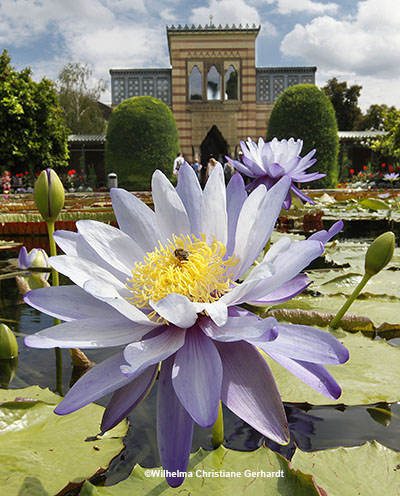 TM: So, it’s well worth visiting the Wilhema several times a year, without getting bored?
TM: So, it’s well worth visiting the Wilhema several times a year, without getting bored?
Dr. Harald Knitter: For sure! That is the great part – since we are also a botanical garden, every season has its own charm. Each spring, summer, fall and winter have their very own ambiance. And then we do have so many different areas you can all visit separately. We do recommend to our visitor to pick one thing they really want to see. One of our strong suits are the apes for example. We have 20 different species of apes and monkeys, from the largest, the gorillas – where the male silverbacks can weight up to 450lbs to the tiniest monkeys that exist, the so called pygmy marmoset, that weigh maybe 150 grams, and are part of the callitrichidae, and are from south America. It really is the case that some of our visitors are interested in certain animals and visit them over and over. Some even decide to become patrons for those animals, but it’s hard to say what makes something a highlight for someone. We do have something special for families with kids: our exercise parkour, it consists of 12 play stations, where the kids are animated to copy the movement of the animals around them. Jumping like a kangaroo, climbing and brachiating like a gibbon, running like a greater rhea, it’s a wonderful thing for the kids that want to let of steam and play.
TM: You just mentioned the sponsorship
Dr. Harald Knitter: Sponsorship is a way to support the Wilhelma and its wildlife conservation program. You have the possibility to support an entire species or a single named animal. You receive a certificate and of course, since it is a donation, a receipt for the taxes. Since its tax deductible if you pay taxes here in Germany. You also get an invitation for sponsorship day, which is held once a year in the fall. The sponsors can then visit the enclosures with the care takers. The care takers that spend every day with the animals talk about the special habits and needs of the animals, maybe even share some quirks of the individual animals that we own. After that all the sponsors are invited in our restaurant for coffee. Now, it is not the case that the animals with sponsors get different treatments then the animals without, or our meercats would be really round. The animals are already well cared for. All the money goes into a pot that finances projects that would otherwise not be possible. The Sponsor money paid for the new updated flamingo pond, we also expanded the bison enclosure and created a Mediterranean outdoor enclosure for lizards and tortoises from the Mediterranean. Those are lovely small projects, that are noticeable and the sponsors can see when they visit – I supported that.
TM: How much does the sponsorship run?
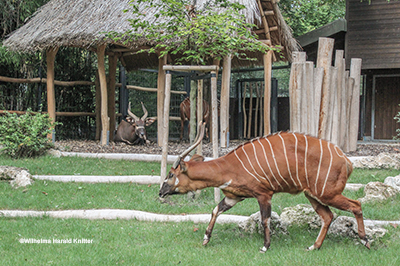 Dr. Harald Knitter: That can vary. There is a list on our homepage online, we differ between size of the animal, how rare the animal is and how many we own. You can start with 50 Euros annually, with many of the animal species. A sponsorship runs for 12 months. You can also choose when to start it. The prices scale up to 100 Euro, 150 Euro and 200 Euro all the way up to the elephants for example. Those are rare and since we have only 2 of them prices can be up to 5000 Euro.
Dr. Harald Knitter: That can vary. There is a list on our homepage online, we differ between size of the animal, how rare the animal is and how many we own. You can start with 50 Euros annually, with many of the animal species. A sponsorship runs for 12 months. You can also choose when to start it. The prices scale up to 100 Euro, 150 Euro and 200 Euro all the way up to the elephants for example. Those are rare and since we have only 2 of them prices can be up to 5000 Euro.
TM: Does the Wilhelma depend on donations?
Dr. Harald Knitter: We want to use the donations in a meaningful fashion. Wilhelma belongs to the state of Baden-Wuerttemberg, so we do get grands from the state- but the state does not pay for everything, and that’s why we need an income too. That is for one the entrance fee, then the donations from things like the sponsorship and kid’s birthday parties. You can celebrate your child’s birthday party at the Wilhema. We do offer a program, depending on where you chose to go, you either spend the day with the animal care taker or a gardener. That gives us another venue to make a little extra money that we need to run the Wilhelma. The kid’s birthday party is ideal for children between the ages 6 to 12/14.
TM: How much will a birthday party run for?
Dr. Harald Knitter: If I remember right it is 110 Euros for the program that lasts about 1,5 hours and additionally to that you have to count in the entrance fees for the guests, the entrance fee is reduced for party members and the birthday child has free entrance anyways. There should be between 8-12 kids for the party. The activities for the party can vary quite a bit. The aquarium is really popular; you get to go behind the scenes, get to see the tanks up close, and may even get to feed some fish. The sea lion feedings are also very sought-after – the commented feeding is very well-known. Part of the aquarium package is also the terrarium, so you get to see snakes and lizards, it’s very versatile.
TM: Is the birthday party available in English language?
Dr. Harald Knitter: I will have to double check on that to see which care takes speak enough English. It is possible to take the guided tours through the Wilhelma in English though.
TM: Thank you so much, Dr. Harald Knitter, for the nice chat and all the information.
Interview taken by Uwe Warnack, CEO Together Magazine
- Details
- Written by Karin Stumph
- Parent Category: Magazine
- Category: Stuttgart Wilhelma Zoo
- Hits: 4219

